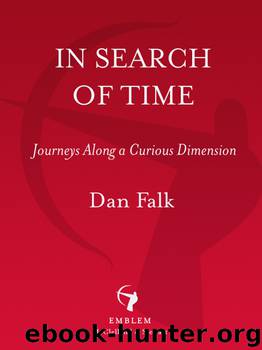In Search of Time by Dan Falk

Author:Dan Falk [Falk, Dan]
Language: eng
Format: epub
ISBN: 978-1-55199-329-4
Publisher: McClelland & Stewart
Published: 2008-01-19T16:00:00+00:00
The Problem of “Now”
The slowing down of fast-moving clocks is just one of the ways in which special relativity assaults our commonsense view of time. It also forces us to re-think the idea of simultaneity. We say that two events are simultaneous if they happen at the same time; in Newton’s world, this was a very straightforward idea. But in Einstein’s universe, we have a problem: two events that may be simultaneous for me may not be simultaneous for you, depending on our relative motion. This is called the “relativity of simultaneity.”
Suppose again that we have a railway car, this time equipped with a couple of simple gadgets: at either end of the car we install a camera’s flash unit along with a photodiode, and we wire it up so that when light, from any source, hits the photodiode, it triggers the flash (upper diagram). (We can imagine that the car is dark enough that unless we introduce extra light, the flash units just sit there and do not fire.) Let’s call the unit on the left A and the one on the right B. Now I take up a position in the middle of the car, halfway between A and B. I have a third flash unit, which I’m holding in my hand. If I set off the flash, what happens? Light from the flash reaches A and B at the same time, and forces them both to fire. From my perspective, the flashes triggered at A and B are simultaneous.
Now imagine that the railway car is moving along from left to right, at some speed close to the speed of light (lower diagram). Standing in the middle of the car, I set off my flash and again see the flashes at A and B as simultaneous. (Einstein’s first postulate demands this; it simply says that I can equally well describe myself as being at rest, with the station and the platform speeding by.) But what does an observer on the ground see? From her perspective, the back of the car (A) is “chasing” the beam of light, while the front of the car (B) is running away from it. From her point of view, the beam travels a shorter distance to reach A than it does to reach B. According to Einstein’s second postulate, she sees the beam itself moving at the usual speed, c – and concludes that the time needed for the beam to reach A, and trigger its flash, is less than the time needed for the beam to reach B. In other words, she sees the flash at A before she sees the flash at B. The events are no longer simultaneous.
Why Simultaneity Is Relative
a) Flash emitted from center of stationary train car
Download
This site does not store any files on its server. We only index and link to content provided by other sites. Please contact the content providers to delete copyright contents if any and email us, we'll remove relevant links or contents immediately.
The Complete Stick Figure Physics Tutorials by Allen Sarah(6632)
Secrets of Antigravity Propulsion: Tesla, UFOs, and Classified Aerospace Technology by Ph.D. Paul A. Laviolette(3432)
Thing Explainer by Randall Munroe(3319)
The River of Consciousness by Oliver Sacks(2989)
The Order of Time by Carlo Rovelli(2708)
I Live in the Future & Here's How It Works by Nick Bilton(2520)
A Brief History of Time by Stephen Hawking(2471)
How To by Randall Munroe(2466)
The Great Unknown by Marcus du Sautoy(2180)
What If?: Serious Scientific Answers to Absurd Hypothetical Questions by Randall Munroe(2166)
Blockchain: Ultimate Step By Step Guide To Understanding Blockchain Technology, Bitcoin Creation, and the future of Money (Novice to Expert) by Keizer Söze(2134)
Midnight in Chernobyl by Adam Higginbotham(2075)
Networks: An Introduction by Newman Mark(1994)
The Meaning of it All by Richard Feynman(1905)
Easy Electronics by Charles Platt(1859)
The Tao of Physics by Fritjof Capra(1842)
When by Daniel H Pink(1771)
Midnight in Chernobyl: The Untold Story of the World's Greatest Nuclear Disaster by Adam Higginbotham(1770)
Introducing Relativity by Bruce Bassett(1751)
